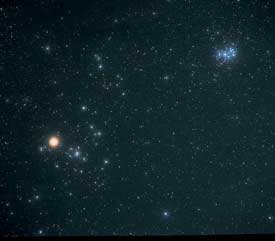
Two open clusters are prominent in the constellation Taurus, the Bull. The Hyades are the large V-shaped group of stars (lower left) with the bright non-member star Aldebaran at one end of the V. The Pleiades (M45) are the compact star group to the upper right.
Courtesy Akira Fujii.
For professional astronomers, the bigger the telescope the better. Large telescopes collect more light, so researchers can probe farther and discern finer detail.
But bigger is not always better for backyard observers. Small optics have a number of advantages. Binoculars and small telescopes are easier to transport and set up, and large deep-sky objects are often best appreciated in their relatively wide fields of view. Today's vast array of such small instruments attests to their increasing popularity.
While some celestial wonders are more impressive in larger telescopes, small instruments — and even your unaided eyes — can show more than they are given credit for, particularly when viewing clusters of stars. Here are a few seasonal highlights for Northern Hemisphere observers (though skygazers below the equator will also be able to find many of these objects).
Summer and M13
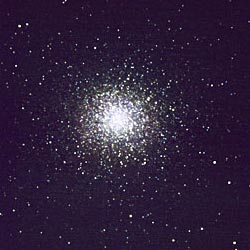
How many of the estimated one million stars can you see in globular cluster M13 in Hercules?
Courtesy Bill and Sally Fletcher.
As the Big Dipper slides down into the western sky in late spring and early summer, the constellation Hercules climbs high into the eastern sky. Within its boundaries lies the best globular cluster in the northern sky, number 13 on Messier's list.
The easiest way to find it in late spring or summer is to get familiar with the distinctive crooked-H shape of Hercules.
Then look for the constellation between the bright stars Arcturus in Boötes and Vega in Lyra. You'll find four stars in the central portion of Hercules that form a pattern called the keystone. Aim your binoculars at the two stars on the right (west) side of the keystone. Look for a fuzzy circular glow, like an out-of-focus star. That's M13, shining across 21,000 light-years of space.
While you can pick out M13 with binoculars, this is one object where a telescope is definitely needed to reveal its true glory. In dark skies and with a good-quality 4-inch or larger telescope, M13 will begin to resolve into hundreds of faint stars. An 8-inch or larger telescope shows M13 appearing like a splattering of sugar grains sparkling in front of a dimmer glow of unresolved stars.
This cluster, like most globulars, actually contains millions of stars collected in a large spherical cloud. M13 and another 150 known globular clusters orbit the Milky Way galaxy like bees swarming around a hive.
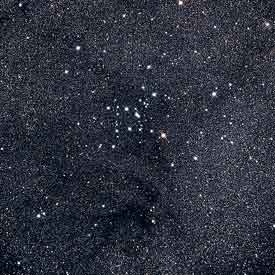
Seen in a small telescope, the open star cluster M7 in Scorpius reveals dozens of jewel-like pinpoints of light.
Courtesy Akira Fujii.
Eight degrees south of Albireo, the head of Cygnus, the Swan, lies an open cluster known as the Coathanger (Collinder 399). Its brightest stars test the limits of naked-eye visibility. Through small binoculars this is a striking group. Its 10 brightest stars are arranged in a pattern that resembles an old-fashioned coathanger with a curved wooden bar and a metal hook. Six stars form the bar and four more to the south make the hook.
Near the stinger of Scorpius lies M7, a real binocular treat. In 50-mm binoculars you can count about 30 stars in this large, beautiful open cluster. Larger glasses will show 60 mixed bright and faint stars. A smaller knot of bright stars, M6, can be seen northwest of M7 in the same field of view. Both are wonderful targets for a small telescope, too.
Autumn and NGC 7789
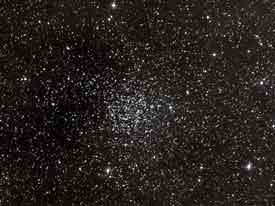
Open clusters like NGC 7789 often contain hundreds of stars that formed in the same cloud of gas and dust at about the same time.
Courtesy Martin C. Germano.
As the summer Milky Way swings into the west, the autumn portion of the Milky Way rises high overhead. Scattered along this section of our galaxy's spiral arms are dozens of open star clusters. These are less populous than globulars, containing a few dozen to several hundred stars. Open clusters have a different history of formation. Globulars are ancient clusters left over from the formation of our galaxy. Open clusters are left when a nebula such as Orion collapses, forms stars, then dissipates into space.
Most open clusters are made of young stars that formed in the active star-making regions of our galaxy's spiral arms. That's why we find most of the sky's open clusters confined to the band of the Milky Way. The autumn Milky Way through Cassiopeia is rich in clusters. To find NGC 7789, one of the best of these groups, first look high overhead and locate the distinctive W-shaped grouping of five stars that marks
Cassiopeia, the Queen.
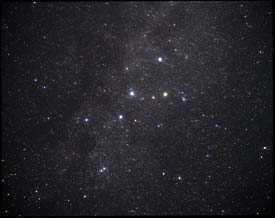
The distinctive W-shape of Cassiopeia is easily seen in the north.
Courtesy Akira Fujii.
Using binoculars, locate the two stars, Alpha and Beta, on the right side of the W. (See the image opposite — Beta is the uppermost star and Alpha is just below it.) They should both fit in the field of view of most binoculars. Center the top star, Beta. Now come off Beta, moving away from the W to the right at a right angle to a line between Alpha and Beta. About half a binocular field away from Beta you should see the cluster — a nebulous, hazy area.
Binoculars may not resolve NGC 7789 well. It takes the added power of a telescope to make it a rich eyepiece full of stars. Just remember to keep the magnification low for the best view. With 300 faint stars packed into an area smaller than the apparent diameter of the Moon, this is one of the richest open clusters in the sky.
Winter and the Pleiades
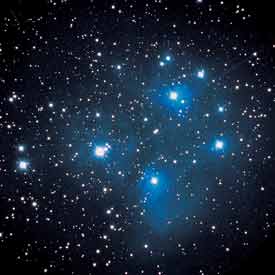
The Pleiades are an impressive sight with any or no optical aid. How many stars can you see with your naked eye?
Courtesy Akira Fujii.
The best-known deep-sky object is the Pleiades or Seven Sisters (M45). This star cluster rests on the shoulders of Taurus, the Bull,
and is easily visible with the naked eye. Most people can see 6 to 10 "Pleiads" with the brightest arranged in the shape of a tiny dipper. The view through binoculars is stunning! You'll see a few dozen stars through 7 x 50 binoculars. Larger binoculars and small telescopes can show more than 100. The Pleiades are wrapped in a faint nebulosity that is a challenge to observe. The brightest part extends southward from the star that marks the lower-left corner of the dipper's bowl.
Perseus is home to some wonderful star clusters. One of the best binocular targets among them is the Alpha Persei association (Melotte 20). This breathtaking group consists of about 20 fairly bright stars and dozens of fainter ones. They are scattered across 3° of sky mostly to the lower right of the group's brightest member, Mirphak (α).
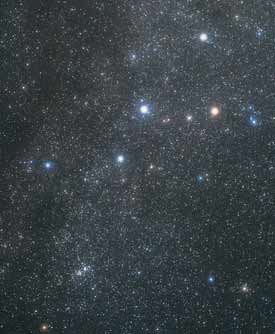
The Double Cluster is easy to find; it's visible toward the bottom of this photograph. Click on the image for a closeup of the region that includes the Double Cluster.
Courtesy Akira Fujii.
To the lower left of Cassiopeia's distinctive W-shape, beneath the stars Delta (δ) and Epsilon (ε) Cas, is another visual treat when seen in binoculars or a small telescope — the Double Cluster in Perseus. Recent studies have revealed that they really are twins — both clusters (also known as NGC 869 and 884) are about 13 million years old and 7,300 light-years away. They're barely visible to the naked eye, but if you're observing on a moonless night, your binoculars will show the Double Cluster as side-by-side clumps of stars imbedded in the thin winter Milky Way.
Spring and the Beehive
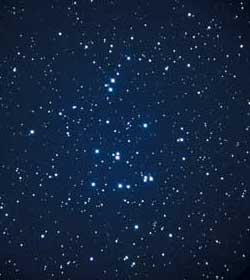
Swing your binoculars toward the Beehive star cluster (M44) in Cancer and you'll be treated to eyefuls of stars.
Courtesy Akira Fujii.
The dim constellation Cancer, the Crab, is often depicted as an upside-down Y. Near the junction of its arms lies the Beehive star cluster (M44). It is faintly visible to the unaided eye as a hazy patch of light. Binoculars reveal 20 fairly bright stars and many dimmer ones. Several of the brighter stars form a V-shaped pattern. A small telescope will reveal that one of the stars in the northern arm of the V is a triple-star system with yellow, blue-white, and white components. Look around — other stars in the cluster also show hints of color.
Many people have seen Melotte 111, but few know it by that name and fewer realize that it's a true star cluster: the sprinkling of faint stars that forms the constellation Coma Berenices (Berenice's Hair). By either name, it looks best in low-power binoculars. Through 8 x 40s, you'll see about 30 fairly bright stars and many fainter ones across the 5°-wide area. The six brightest roughly form an upside-down Y. The one at the end of its southeast branch (17 Comae Berenices) is actually a double star.
 0
0
Comments
You must be logged in to post a comment.